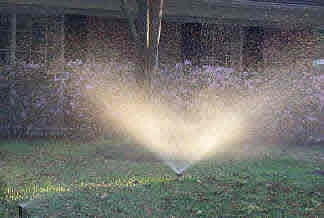Houston Sprinkler Watering | Instructions and Tips

Sprinkler Watering Instructions
Texas Licensed Irrigator #4846
General
These instructions cover a broad range of plants and planting conditions. Each set of instructions is meant to cover the majority of plants under most conditions and is to be used as a guide to help you care for your plants. Newly planted areas, extremely hot areas, shady areas, steep grades (slopes) and narrow areas may require more or less water than the recommended amount below.
Watering
Different soil types and percolation rates will vary the amount and length of watering. The best source for watering is an automatic sprinkler system. With an automatic sprinkler system you have control of when and how much water to apply to specific areas. If your existing automatic sprinkler system has been designed properly and the coverage is adequate, you should water shrubs and ground cover areas 3-5 minutes.
Turf areas require more water and time, approximately 5-7 minutes. Note: soil types may not allow you to water this length of time, check for water runoff into the street. Water run-off is usually a good indication that your ground will not take up any more water (an indication of a more compact soil or clay soil).
To help percolation of water and nutrients for turf areas it is advised to aerate twice a year. Adjust water rates based on your soil type and soil condition. New vegetation requires more frequent watering until a root zone is established. Hot summer months may require two waterings a day, once early in the morning around 4:00 a.m. to 6:00 a.m., and one short watering (about half of the morning's programmed time) around 4:00-4:30 p.m.
As a general rule, water every other day in the spring and once a day every day in the summer. During extremely hot months and long periods of drought, water twice a day as mentioned earlier. The second watering should be enough to lightly water the plants and cool them down. You want to avoid leaving the ground too wet.
Provided there is adequate rainfall, you can usually turn the system off from November to January. You can water as needed if there is no rainfall. It is also good to water just before a freeze, to help insulate the plants.
As much as possible, water early in the morning. The water pressure is at its best, there is usually less wind, the air is still relatively cool, and thus you will lose less water to evaporation. Also, the sun angle will not let droplets of water on foliage magnify the sun's rays and burn the leaves.
After watering, check to see if you have moisture at least 4" to 6" below the soil's surface. A good quality moisture meter will work or a small shovel or your fingers are best. This is also a good way to check between waterings, to see if your schedule is appropriate.
It is important to avoid constant over watering and under watering. This will stress and possibly kill the plant. Scheduled consistent watering maintains a balanced moisture level and a healthier plant.
Under watering is better than over watering!
Frost Protection
One of the best protections for freeze damage is moist roots, water thoroughly the night before a heavy freeze. This water uptake will help insulate the plant cells. A heavy layer of insulating mulch. (2" minimum) will also help protect roots.. Be certain to remove covering on any covered plant as soon as temperature permits. Use cloth or a bed sheet as opposed to plastic which will burn plant foliage. If you must use plastic, do not let it touch the leaves of the plant.
- Common Contractor Shortcuts
- Helpful Tips When Selecting A Contractor
- Frequently Asked Questions
- Points To Remember
- Terms And Definitions
- Watering Schedule
- Winterizing Sprinkler System
- Drip Irrigation
- Sprinkler System Options
- Pressure Vacuum Breaker Inspections
- Sprinkler System Basic Troubleshooting
- Upgrade Existing Sprinkler System